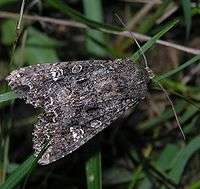Cabbage moth
| Cabbage moth | |
|---|---|
 | |
| Scientific classification | |
| Kingdom: | Animalia |
| Phylum: | Arthropoda |
| Class: | Insecta |
| Order: | Lepidoptera |
| Family: | Noctuidae |
| Genus: | Mamestra |
| Species: | M. brassicae |
| Binomial name | |
| Mamestra brassicae (Linnaeus, 1758) | |
- Note: the small white species of butterfly is commonly called a "cabbage moth" in North America.
The cabbage moth (Mamestra brassicae) is a common Palearctic moth of the family Noctuidae. It is found in Europe, Russia and across the Palearctic to Japan.

This species varies in size, with a wingspan of 34–50 mm. The forewings are brown and mottled with a prominent white-edged stigma and a broken white sub terminal line.[1][2] The hindwings are grey, darker towards the termen. The prominent spur on the tibia of the foreleg is a diagnostic feature, though is best viewed with a magnifying lens. This moth has two or three broods are produced each year and adults can be seen at any time from May to October, occasionally at other times . It flies at night and is attracted to light, sugar and nectar-rich flowers.
Technical description and variation
The wingspan is 34–50 mm. Forewing grey-brown varied with fuscous: lines pale, dark-edged; orbicular stigma rounded, reniform large, white-spotted, or filled in with white; hindwing brownish, with a paler mark near end of vein 2. The insect varies in opposite directions;
- -ab. albidilinea Haw is a blackish form with the reniform stigma and submarginal line white, occurring occasionally in Europe as well as in Britain; — scotochroma Rob., a local German form, is melanic, with both wings blackish, much like albidilinea, but without the white submarginal line;
- - unicolor Tutt has all the markings dark and light, more or less lost in the fuscous suffusion, the reniform edged only with whitish;
- - andalusica Stgr. from Spain is pale grey-brown with a faint ochreous flush, darker grey in female, with all markings obscured except the 3 stigmata, which are strikingly pale, with partial blackish outline, especially on their lower edge, the claviform sometimes grey;
- — decolorata Stgr. from Issyk Kul and other localities in Central Asia is pale greyish brown, with the stigmata as in andalusica, but with the markings, especially the submarginal ones, not obsolete;
- — canescens Moore from Yarkand is, judging from the figure, very close to, if not identical with, decolorata which it antedates by 10 years.
Larva varying in ground colour from green to brown and blackish, with broad pale spiracular line; a dorsal hump on segment 11: with dorsal and lateral stripes;[4] dark dorsal marks,[5] various white dorsal and lateral spots;[5][6] dark 'tyre tread' marks;[7] brown 'eye' marks,[4] and a dark back central back stripe.;[8] grey dorsum, pale lateral stripe and tan versum.;[9] red-brown earth colour;[4] grey-brown earth colour;[10] tan dorsum, white and then yellow stripe and pink ventrum.;[4] green, khaki, grey-brown or brown with dark spots;[1][2][10] green-grey dorsum, yellow stripe and light green ventrum;[11] grey green with a dark green dorsal stripe;[12] black dorsum, yellow lateral stripe and light yellow green versum[8]*
- ^ The flight season refers to the one in the British Isles. This may vary in other parts of the range.
Recorded food plants

.jpg)
- Allium – onion
- Aquilegia – columbine
- Beta – beet
- Brassica
- Bryonia – Bryony
- Calendula – marigold
- Cannabis – marijuana
- Chrysanthemum
- Cucurbita
- Dianthus – carnation
- Helianthus – sunflower
- Hyoscyamus – henbane
- Hyssopus – hyssop
- Lactuca – lettuce
- Linum – flax
- Lychnis – Maltese cross
- Lycopersicon – tomato
- Malus – apple
- Nicotiana – tobacco
- Pisum – pea
- Plantago – plantain
- Raphanus – radish
- Rheum – rhubarb
- Rudbeckia
- Rumex
- Silene
- Solanum – potato
- Spinacia – spinach
See Robinson, G. S. et al.[13]
References
- 1 2 "Interesting (To Us) Photos From The Garden". Meades.org. Retrieved 2011-08-11.
- 1 2 "RXwildlife Sightings » Blog Archive » More Emergence". Rxwildlife.org.uk. 2009-06-03. Retrieved 2011-08-11.
- ↑ Seitz, A. Ed., 1914 Die Großschmetterlinge der Erde, Verlag Alfred Kernen, Stuttgart Band 3: Abt. 1, Die Großschmetterlinge des palaearktischen Faunengebietes, Die palaearktischen eulenartigen Nachtfalter, 1914
- 1 2 3 4 "Noctuidae - Noctuinae - Apameini, Dypterygiini, Hadenini, Leucaniini". Commanster.eu. Retrieved 2014-08-11.
- 1 2 "INSECTES13-4'-1". Aramel.free.fr. 2010-06-16. Retrieved 2014-08-11.
- ↑ "The Moths and Butterflies of Huntingdonshire". Hmbg.org. Retrieved 2014-08-11.
- ↑ "Cabbage Moth - Mamestra brassicae". NatureSpot. Retrieved 2014-08-11.
- 1 2 "Europäische Schmetterlinge und ihre Ökologie: Mamestra brassicae". Pyrgus.de. Retrieved 2014-08-11.
- ↑ http://www7.inra.fr/hyppz/IMAGES/7032162.jpg
- 1 2 "Cabbage Moth - Caterpillar". Habitas.org.uk. Retrieved 2014-08-11.
- ↑ "Mamestra brassicae larva cabbage moth Koppert Biological Systems 6050 | Flickr - Photo Sharing!". Flickr. 2008-04-14. Retrieved 2014-08-11.
- ↑ "The Moths and Butterflies of Huntingdonshire". Hmbg.org. Retrieved 2014-08-11.
- ↑ "Robinson, G. S., P. R. Ackery, I. J. Kitching, G. W. Beccaloni & L. M. Hernández, 2010. HOSTS - A Database of the World's Lepidopteran Hostplants. Natural History Museum, London.".
- Chinery, Michael Collins Guide to the Insects of Britain and Western Europe 1986 (Reprinted 1991)
- Skinner, Bernard Colour Identification Guide to Moths of the British Isles 1984
External links
| Wikimedia Commons has media related to Cabbage moth. |
- Lepiforum
- Funet Taxonomy
- Fauna Europaea